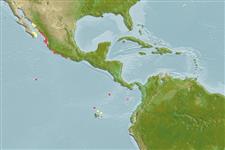>
Blenniiformes (Blennies) >
Tripterygiidae (Triplefin blennies) > Tripterygiinae
Etymology: Axoclinus: Greek, axis = axis + Greek, klinein = sloping and bed, due to the four apophyses of sphenoid bone.
Environment: milieu / climate zone / depth range / distribution range
Ecologia
marinhas demersal; intervalo de profundidade 7 - 8 m (Ref. 46206). Tropical
Eastern Central Pacific: Isla del Coco. A very similar but possibly undescribed species from the Revillagigedo Islands.
Tamanho / Peso / Idade
Maturity: Lm ? range ? - ? cm
Max length : 3.5 cm TL macho/indeterminado; (Ref. 11482)
Descrição breve
Morfologia | Morfometria
Espinhos dorsais (total): 16; Raios dorsais moles (total): 9; Espinhos anais 2; Raios anais moles: 18. Lateral line gradually descending from upper edge of gill cover to midlateral axis; lateral line with 21-26 tubed scales followed by 8-12 notched scales; total scales in longitudinal series 33-35; a small lanceolate cirrus on upper edge of eye. Head pink to reddish; side with 3 broad, dark brown bars with narrow, whitish spaces between them; a black band around base of caudal fin; caudal fin frequently black (Ref. 11482).
Adults inhabit shallow rocky areas. They feed on tiny invertebrates and algae (Ref. 11482). Eggs are hemispherical and covered with numerous sticky threads that anchor them in the algae on the nesting sites (Ref. 240). Larvae are planktonic which occur primarily in shallow, nearshore waters (Ref. 94114).
Life cycle and mating behavior
Maturidade | Reprodução | Desova | Ovos | Fecundidade | Larvas
Fricke, R., 1997. Tripterygiid fishes of the western and central Pacific, with descriptions of 15 new species, including an annotated checklist of world Tripterygiidae (Teleostei). Theses Zool. 29:1-607. (Ref. 27223)
Categoria na Lista Vermelha da IUCN (Ref. 130435)
Ameaça para o homem
Harmless
Utilização humana
Mais informação
Nomes comunsSinónimosMetabolismoPredadoresEcotoxicologiaReproduçãoMaturidadeDesovaAgregação para desovaFecundidadeOvosDesenvolvimento dos ovos
Idade/TamanhoCrescimentoComprimento-pesoComprimento-comprimentoFrequência de comprimentoMorfometriaMorfologiaLarvasDinâmica larvarRecrutamentoAbundânciaBRUVS
ReferênciasAquaculturaPerfil para aquaculturaEstirpesGenéticaElectrophoresesHereditariedadeDoençasProcessamentoNutrientsMass conversion
ColaboradoresFotografiasStamps, Coins Misc.SonsCiguateraVelocidadeTipo de nataçãoÁrea branquialOutras referênciasCérebrosVisão
Ferramentas
Relatórios especiais
Descarregue XML
Fontes da internet
Estimates based on models
Preferred temperature (Ref.
123201): 24.8 - 29.1, mean 28 °C (based on 105 cells).
Phylogenetic diversity index (Ref.
82804): PD
50 = 0.5156 [Uniqueness, from 0.5 = low to 2.0 = high].
Bayesian length-weight: a=0.00562 (0.00258 - 0.01228), b=3.08 (2.89 - 3.27), in cm total length, based on LWR estimates for this (Sub)family-body shape (Ref.
93245).
Nível Trófico (Ref.
69278): 2.8 ±0.26 se; based on food items.
Resiliência (Ref.
120179): Elevada, tempo mínimo de duplicação da população menor que 15 meses (Preliminary K or Fecundity.).
Fishing Vulnerability (Ref.
59153): Low vulnerability (10 of 100).
